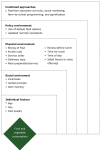Factors Related to Fruit and Vegetable Consumption at Lunch Among Elementary Students: A Scoping Review
- PMID: 29752802
- PMCID: PMC5951150
- DOI: 10.5888/pcd15.170373
Factors Related to Fruit and Vegetable Consumption at Lunch Among Elementary Students: A Scoping Review
Abstract
Introduction: Few children consume the recommended amount of fruits and vegetables, and schools are a valuable setting for interventions, including programs such as the National School Lunch Program, to increase consumption. Previous research explored factors in this program that influence fruit and vegetable consumption. The objective of this scoping review was to identify, describe, and categorize studies that quantitatively measured the consumption of fruits and vegetables during the school lunch meal among US elementary school students.
Methods: We conducted a scoping review to identify, describe, and categorize studies examining factors influencing fruit and vegetable consumption during lunch among children in the United States. Eligibility criteria included studies that reported fruit and vegetable consumption at the lunch meal among children in kindergarten through grade 5. We included all types of study designs and categorized factors according to a socioecological framework.
Results: We identified 49 studies that examined the influence of one or more factors on elementary students' consumption of fruits and vegetables. Factors (n = 21) were categorized according to a socioecological framework: individual (3 factors), social environment (3 factors), physical environment (9 factors), policy (2 factors), and a combined approach (4 factors). Several factors had consistent positive associations with fruit and vegetable consumption at lunch across 2 or more studies: increasing age, serving sliced fruits, serving vegetables first, allowing more time for eating, using incentives, using social marketing and/or nutrition education curricula, and using the updated nutrition standards. Only 10 studies used a randomized design.
Conclusion: Although we found consistent evidence for some factors, we found conflicting or limited evidence for most, which points to the need for replication in future studies. The lack of randomized designs is a challenge, because it precludes the ability to draw conclusions about cause and effect. Our review may aid in framing practical aspects of the design of future research and in identifying an approach for a systematic review.
Figures
Similar articles
-
Wellness in the Schools: A Lunch Intervention Increases Fruit and Vegetable Consumption.Nutrients. 2021 Sep 2;13(9):3085. doi: 10.3390/nu13093085. Nutrients. 2021. PMID: 34578962 Free PMC article.
-
Differential Improvements in Student Fruit and Vegetable Selection and Consumption in Response to the New National School Lunch Program Regulations: A Pilot Study.J Acad Nutr Diet. 2015 May;115(5):743-750. doi: 10.1016/j.jand.2014.10.021. Epub 2015 Jan 2. J Acad Nutr Diet. 2015. PMID: 25556770 Free PMC article. Clinical Trial.
-
Cafeteria noise exposure and fruit and vegetable consumption at school lunch: A cross-sectional study of elementary students.Appetite. 2019 May 1;136:130-136. doi: 10.1016/j.appet.2019.01.026. Epub 2019 Jan 31. Appetite. 2019. PMID: 30711485
-
Interventions for increasing fruit and vegetable consumption in children aged five years and under.Cochrane Database Syst Rev. 2020 May 25;5(5):CD008552. doi: 10.1002/14651858.CD008552.pub7. Cochrane Database Syst Rev. 2020. Update in: Cochrane Database Syst Rev. 2024 Sep 23;9:CD008552. doi: 10.1002/14651858.CD008552.pub8. PMID: 32449203 Free PMC article. Updated.
-
Interventions for increasing fruit and vegetable consumption in children aged five years and under.Cochrane Database Syst Rev. 2019 Nov 7;2019(11):CD008552. doi: 10.1002/14651858.CD008552.pub6. Cochrane Database Syst Rev. 2019. Update in: Cochrane Database Syst Rev. 2020 May 25;5:CD008552. doi: 10.1002/14651858.CD008552.pub7. PMID: 31697869 Free PMC article. Updated.
Cited by
-
Strategies to Improve School Meal Consumption: A Systematic Review.Nutrients. 2021 Oct 7;13(10):3520. doi: 10.3390/nu13103520. Nutrients. 2021. PMID: 34684521 Free PMC article.
-
Wellness in the Schools: A Lunch Intervention Increases Fruit and Vegetable Consumption.Nutrients. 2021 Sep 2;13(9):3085. doi: 10.3390/nu13093085. Nutrients. 2021. PMID: 34578962 Free PMC article.
-
Impact of School Gardens on Nutrition Education Among Limited-Income Communities in Alabama.J Sch Health. 2025 Feb;95(2):153-161. doi: 10.1111/josh.13513. Epub 2024 Oct 26. J Sch Health. 2025. PMID: 39460463 Free PMC article. Clinical Trial.
-
Zero fruits/vegetables consumption and associated factors among Children aged 6-23 months in Ethiopia: Mixed effect logistic regression analysis.PLoS One. 2023 Jul 14;18(7):e0288732. doi: 10.1371/journal.pone.0288732. eCollection 2023. PLoS One. 2023. PMID: 37450483 Free PMC article.
-
Interventions to Increase Colorectal Cancer Screening Uptake in Rural Settings: A Scoping Review.Prev Chronic Dis. 2025 Jul 17;22:E44. doi: 10.5888/pcd22.250025. Prev Chronic Dis. 2025. PMID: 40674655 Free PMC article.
References
-
- Dietary Guidelines Advisory Committee; Scientific Report of the 2015 Dietary Guidelines Advisory Committee. 2015. https://health.gov/dietaryguidelines/2015-scientific-report/. Accessed February 10, 2016.
-
- Institute of Medicine. Accelerating progress in obesity prevention: solving the weight of the nation. Washington (DC): National Academies Press; 2012. - PubMed
-
- US Department of Agriculture. Nutrition standards in the National School Lunch and School Breakfast programs. Federal Register. Vol. 77, no. 17. January 26, 2102. https://www.gpo.gov/fdsys/pkg/FR-2012-01-26/pdf/2012-1010.pdf. Accessed February 27, 2018.
Publication types
MeSH terms
LinkOut - more resources
Full Text Sources
Other Literature Sources


